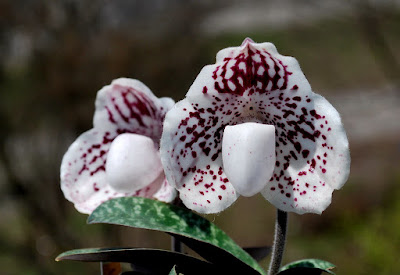Paphiopedilum godefroyae is found in Vietnam, Malaysia ,Peninsular Thailand and adjacent islands such as the islands of the Krabi-Phuket Gulf to the west and the Bird’s Nest Islands to the east. It grows on the ground (less lithophyte on rocks) in tropical moist forest at an altitude from sea level to 100 m above sea level...
Paphiopedilum godefroyae also called as Mrs. Godefroy's Paphiopedilum, Cordula godefroyae, Cypripedium godefroye, Cypripedium concolor var. godefroyae, Paphiopedilum godefroyae f. album, is a species of the genus Paphiopedilum. This species was described by Berthold Stein in 1892.
IDENTIFY PAPHIOPEDILUM GODEFROYAE
Paphiopedilum godefroyae is found in Vietnam, Malaysia ,Peninsular Thailand and adjacent islands such as the islands of the Krabi-Phuket Gulf to the west and the Bird’s Nest Islands to the east. It grows on the ground (less lithophyte on rocks) in tropical moist forest at an altitude from sea level to 100 m above sea level.
It is a small sized, hot growing lowland terrestrial or lithophytic linear-oblong, dark green mottled with pale green, 15 cm long and 3 cm wide leaves with reddish underneath.
Mrs. Godefroy's Paphiopedilum blooms in the summer till spring on an erect, terminal, 7.5 to 10 cm long, 1 or 2 flowered, pale green to purple, tomentose inflorescence and can take some full sun. The flowers are white with brown or purple spots, about 6 cm in diameter.
PAPHIOPEDILUM GODEFROYAE CARE AND CULTURE
Cultural information should only be used as a guide, and should be to be adapted to suit you. Your physical location; where you grow your plants, how much time you have to devote to their care, and many other factors, will need to be taken into account. Only then can you decide on the cultural methods that best suit you and your plants.
Light:
Paphiopedilum godefroyae loves the bright sun without access to direct sunlight, so during the hot afternoon sun on the windows of the southern orientation and the hot evening sun on the western windows, the orchid should be placed behind the curtain (for example on a table near the window) or in the shadow of other plants, otherwise the plant can get a sunburn.
Temperature:
This kind of orchid belongs to a warm temperature regime, and it is recommended to keep the orchids under the following conditions throughout the year: Summer temperature is up to 32 ° C. Winter temperature at 10-18 ° C. For the successful cultivation at home, it is necessary that the night temperature of the content is always 4 ° C lower than the daytime temperature.
Humidity:
For normal growth and development Mrs. Godefroy's Paphiopedilum needs the humidity level of 50-70%. Too dry air adversely affects the development of the plant and its leaves become pale and begin to dry out.
Substrate, growing media and repotting:
Paphiopedilum godefroyae is grown mainly in pots. As a substrate, it is recommended to use a mixture of bark of coniferous trees with coconut chips, sphagnum moss with the mandatory addition of dolomite flour or chalk necessary to adjust the acidity of the substrate, which should be of the order of 7-8 PH.
Watering:
Watering this kind of orchids directly depends on the total temperature of the content, the higher it is, the more often the orchid needs to be watered. Excess water during watering should flow freely out of the pot, as the stagnation of water both inside the pot and in its pan can very quickly lead to decay of the roots and the lower part of the plant. The substrate between the irrigations should dry relatively well, but do not dry completely.
Fertilizer:
In the period of active growth, this type of orchids is fertilized not more often than once a month in 1/2 or 1/3 of the fertilizer concentration indicated on the package. In addition to the usual root dressing, it is also recommended to produce a foliar dressing when a very dilute fertilizer sprayed with orchid leaves. It is best to feed the plant, alternating both these methods.
To avoid very rapid salinization of the substrate, once every 3-4 months it needs to be washed well. For these purposes, the pot with the orchid should be put in the sink and several times pass through the substrate a jet of warm water. The first signs of salinization of the substrate are the blackening of the tips of the leaves of the orchids. In case of particularly severe damage, the plant should immediately be transplanted into a new substrate.
Rest period:
To stimulate flowering, Paphiopedilum godefroyae needs a clearly defined rest period. It begins in mid-November and is expressed in the fact that the orchid is kept somewhat drier and colder than usual and does not fertilize. The most suitable temperature for this period is 15 ° C. Watering the orchids is desirable to replace with light spraying of the substrate and perform this procedure not more often than once in 2-3 weeks. After the appearance of peduncles (usually in February), the rest period ends: the watering of the orchid resumes in the usual volume, and the overall temperature of the contents rises.

















Thank you. For Good and useful information.
Delete